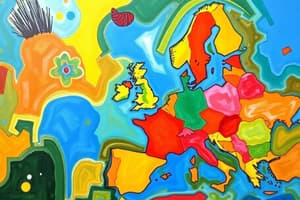Podcast
Questions and Answers
What is a map scale?
What is a map scale?
- A ratio representing the relationship between map distance and ground distance (correct)
- Information about symbols used on a map
- Visual representations of features on a map
- A system of grid lines on a map
What do contour lines on a map represent?
What do contour lines on a map represent?
- Elevation of land (correct)
- Symbols used for roads and cities
- Grid systems for location referencing
- Ratio between map distance and ground distance
How do projection types like Mercator and Equirectangular impact maps?
How do projection types like Mercator and Equirectangular impact maps?
- They indicate distances between locations
- They distort the Earth's surface in various ways (correct)
- They provide information about symbols used on a map
- They help locate specific locations on a map
What is the main purpose of a map key?
What is the main purpose of a map key?
In what way are aerial photographs different from maps?
In what way are aerial photographs different from maps?
Flashcards
Map Scale
Map Scale
A ratio representing the relationship between a unit of distance on a map and the corresponding distance on the ground.
Cartographic Symbols
Cartographic Symbols
Visual representations of features on a map, including roads, cities, and rivers.
Thematic Map
Thematic Map
A map that focuses on a specific theme, such as population density, weather patterns, or soil types.
Grid System
Grid System
Signup and view all the flashcards
Contour Lines
Contour Lines
Signup and view all the flashcards
Study Notes
Mapping Your Way to Geography Skills
Maps have been guiding our understanding of the world for centuries, serving as essential tools for navigating both physical and conceptual terrains. In this article, we'll take a closer look at maps and their role in sharpening our geographical insight and skills.
History of Mapping
Maps have evolved from simple sketches to sophisticated digital creations, but their core purpose remains the same: to visually represent spatial relationships. The earliest known maps date back to around 3,000 BCE in the form of cave paintings and hieroglyphs, and by the 5th century BCE, maps were being used by the ancient Greeks to record their explorations. Over the centuries, maps have evolved with technologies like the compass, satellite imagery, and geographic information systems (GIS), allowing us to better understand and explore our world.
Types of Maps
Maps come in a variety of formats and serve specific purposes:
- Topographic maps: These map surfaces and elevations for planning, hiking, and other outdoor activities.
- Thematic maps: These maps focus on a particular theme, such as population density, weather patterns, or soil types.
- Political maps: These maps show the boundaries, names, and features of political units like countries, states, or provinces.
- Road maps: These maps display transportation routes, such as highways and roads, for drivers and travelers.
- Aerial photographs: These maps are photographs taken from an airplane, drone, or satellite, providing detailed images of the Earth's surface.
Map Skills and Geography Education
Learning to read and create maps is fundamental to understanding the world around us. Here are some map skills and concepts essential to geography education:
- Map scale: A map scale is a ratio that represents the relationship between a unit of distance on a map and the corresponding distance on the ground.
- Grid systems: Grid systems, such as the Universal Transverse Mercator (UTM) system, help us locate and reference specific locations on a map.
- Projection types: Projection types, such as Mercator, Equirectangular, and Robinson, distort the Earth's surface in various ways to make it easier to read and use maps.
- Contour lines: Contour lines represent the elevation of land, helping us visualize ridges, valleys, and other topographical features.
- Cartographic symbols: Cartographic symbols are visual representations of features on a map, including roads, cities, and rivers.
- Map key: A map key provides information about the symbols used on a map, such as their color, shape, and meaning.
Map Usage and Applications
Maps are not only essential for geography education but also have numerous real-world applications:
- Navigation: Maps help us navigate our surroundings, whether we are traveling by car, hiking a trail, or exploring a new city.
- Planning: Maps are used in planning projects, such as infrastructure development, land use management, and urban planning.
- Environmental conservation: Maps are crucial for environmental conservation efforts, such as wildlife habitat protection, forest management, and watershed protection.
- Research: Maps provide a wealth of information for researchers studying geography, history, and other topics.
- Education: Maps are used in classrooms around the world to teach students about geography, culture, and history.
In summary, maps are vital tools that help us understand and explore our world. By learning about the history, types, and skills associated with maps, we can enhance our geographical knowledge and skills, making the world a more exciting and accessible place.
Studying That Suits You
Use AI to generate personalized quizzes and flashcards to suit your learning preferences.




